Scan-Window and Scan-Process
Clicking the scan-icon will open the scan-window.
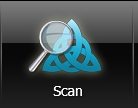
All bandpasses are without content so far.
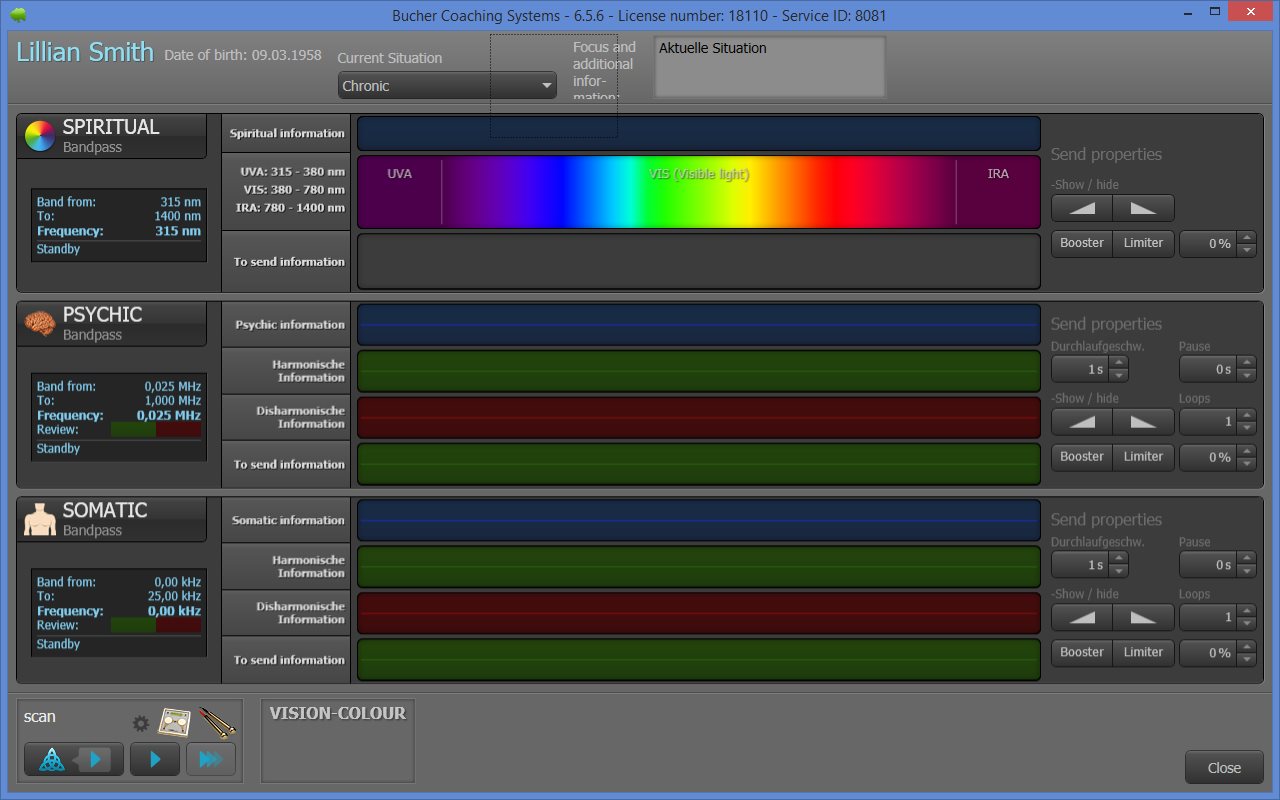
Initially the therapist must determine the “current situation”. For this purpose one of the following options may be chosen:
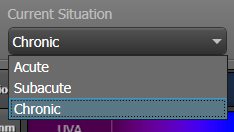
Acute
This option should be chosen if the problem occurred rapidly and severely, within relatively short time (3 to 14 days).
Sub-acute
This option should be chosen when dealing with less severe symptoms which occurred within a time frame of two to four weeks.
Chronic
This option should be chosen when dealing with slowly developing or long lasting illness and the course of the disease is longer than four weeks.
The goal of the treatment may be entered into the field “focus and additional information”. If this field is left blank, the scan and transmission will relate to the patient's “current situation”. Further information such as a homeopathic medicine or an affirmation may be entered here as well, which may later be taken into consideration during transmission process.

Here the type and method of scan-process may be set. The possible choices depend on the connected hardware.
Four different tuners are on sale which offer different functionality. All four device-variations include hand electrodes for measuring the patient's vibration.
Example: Bio-Signal-Tuner
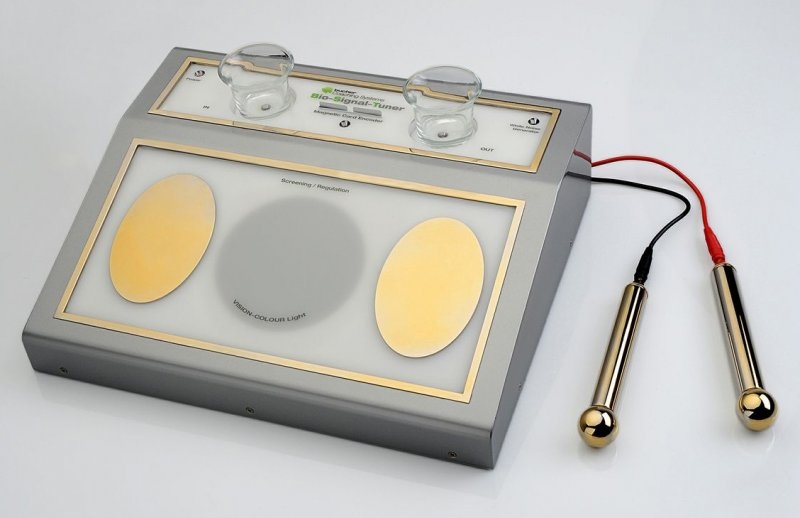
There are two different types of scanning:
The left, slightly larger button offers the type of scan recommended by the system (initial or follow-up measurement). The button in the center will definitely perform an initial scan. The right button will definitely perform a follow-up scan.
In the following picture one can see the first button when the system recommends an initial measurement.

The following pictures shows the first button when the system recommends a follow-up scan.

For safety purposes it is not possible to perform two initial scans within 15 minutes or less. If attempted, the scan will abort with an appropriate notification.
It is further not recommended to perform an initial scan twice within 24 hours. Thus you will also receive a warning if you attempt that, however, you may decide to perform it anyways.
Follow-up scans can be performed as often as desired at any intervals.
1. Initial Scan
The Initial Scan (symbolized by a triangle) collects the patient's vibrations at the time of initial measurement.
2. Follow-up Scan
The follow-up scan (symbolized by three triangles) does not determine the patient's current vibration. Instead it checks for changes compared to the patient's vibrations found in the initial scan. If the patient was successful in working on or out his issues, the disharmonic vibrations will decrease.
Follow-up scans are suggested by the system until the disharmonic vibration has completely cleared or until the initial scan is older than 42 days.
If the initial measurement is older than 42 days and the disharmonic vibrations haven't decreased to 0, the system will suggest a new initial measurement (symbolized by a triangle). A new approach toward solving the problem should be taken instead of permanent attempts of working out old issues. The new attempt may prove to be more successful.
Once all disharmonic vibrations have been cleared (the red areas of the bands show nothing but a “zero curve”), this measurement no longer needs to be worked on. In this case the system will automatically suggest an initial measurement (symbolized by a triangle).
A measurement cycle consists of a first initial measurement and corresponding follow-up measurements. Execution of an initial scan tests the patient's vibration for harmonic and disharmonic values at the time of the initial measurement.
The execution of a follow-up scan tests to which extent the disharmonic values of the corresponding initial measurement have been converted.
If this goal is reached (when all disharmonic values of the vibration are now harmonic), then this measurement cycle is completed and another measurement cycle with a new initial measurement may be started.
Once all settings have been configured, the electrodes are handed over to the patient. The patient is to sit comfortably or lay down and enclose the hand electrodes with his hands. Generally the patient should hold the electrode with the red wire in his strong hand and the electrode with the black wire in the other one. The appointment doesn't matter in people who use both hands or were trained to use the right hand when naturally they would've used the left.
Now the scan process may be initiated by clicking the scan button. First the spiritual bandpass is scanned and then the psychic and then the somatic bandpass. Various processes such as separation, inversion and completion take place during the scan.
Some cases of very dry skin may lead to an abortion of the process. Skin lotion or oil can be used to moisturize the skin and enable a safe measurement. The colors which resonated with the patient (wavelengths) and patient's vibration in the psychic and somatic bandpasses are displayed after the measurement.
The scan is automatically saved including time and date and is thus completed.
The amount of harmonic and disharmonic patient vibrations are put in relation and displayed as percentages in the “Rating” field.
The green portion of vibrations represents positive harmonic vibration, while the red portion represents negative, disharmonic vibration. One can see the size of the bars on the chart, as well as the correlating percentages left and right in the bar.

The more red (disharmonic) patient vibrations are found, the more severe one should rate the patient's problem.
Transmission properties are also scanned and pose a meaningful suggestion which may be adjusted by the therapist, but in most cases can be directly applied to the transmission.
A detailed explanation of transmission properties can be found in the following description of transmission.
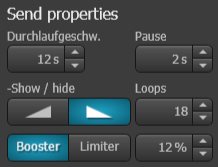
Transmission and further scans can clear the patient's problem over time. Simultaneously the system documents the current status of the relationship of harmonic and disharmonic curves. The disharmonic vibrations clear over time and move “upwards” into the green area, to the harmonic vibrations.
Goal is clearing all disharmonies, so that the disharmonic curve represents a zero line.
Once this is reached in both bandpasses (the psychic and the somatic), the treatment is completed. One may then begin another measurement cycle with a new initial measurement to work on new issues and problems, or those that haven't been completely worked out.
The blue area of a bandpass shows the complete recorded patient vibration with all harmonic and disharmonic frequencies. The following example shows an initial measurement of somatic vibration.

Let's take a closer look at the upper (blue) area of the frequency band (very right).
The blue area of the frequency band was split into the green (harmonic) vibration and the red (disharmonic) vibration.
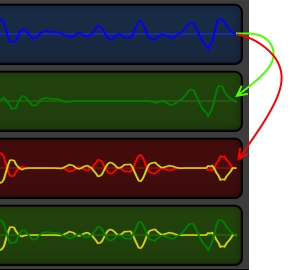
As clearly visible in this example, there is an amplitude in the harmonic area (green), which is missing from the disharmonic area (red). This is highlighted in the following illustration using white circles.
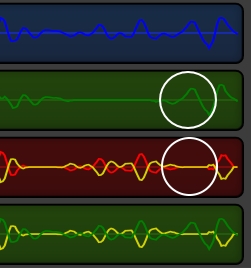
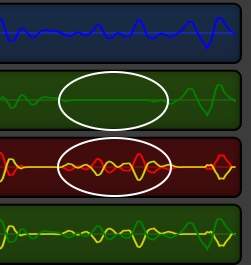
In each case a week later a further scan and transmission were performed. The curves were affected as follows.
The second measurement after one week:
Part of the disharmonic frequencies has already cleared and travelled upwards to the harmonic area.
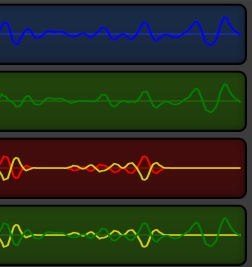
The third measurement after two weeks:
Part of the disharmonic frequency in the red area have cleared and completely transferred into the harmonic area (green).
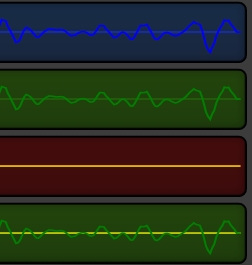
Optimally all amplitudes in the red areas of the bandpasses should go toward NULL over time and begin to appear in the harmonic area (green).
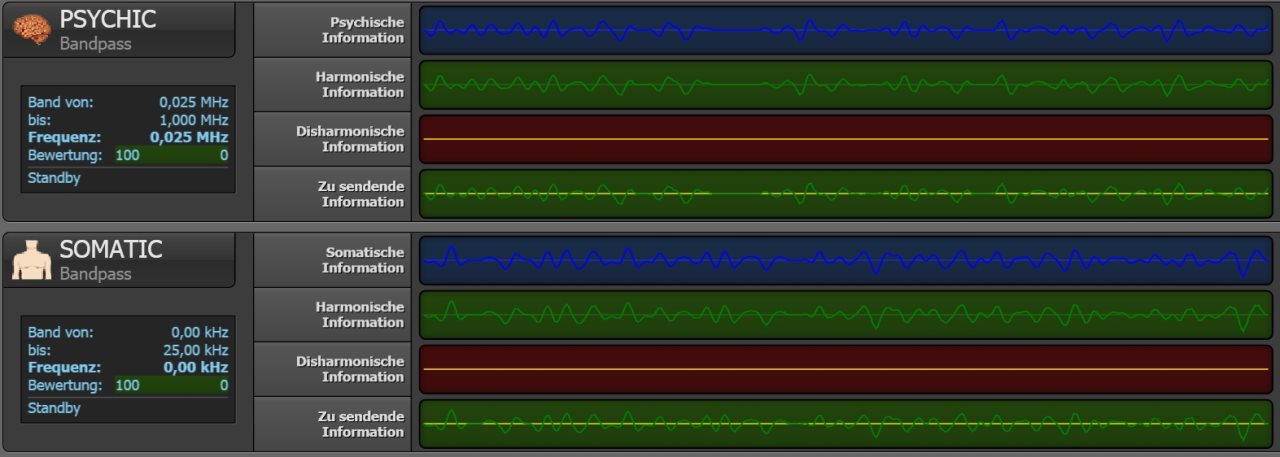
If all disharmonic (red) areas no longer show any amplitudes, the goal of therapy was reached and the measurement cycle is completed.
Generally scans are performed once a week. One should use the scan-type (initial scan or follow-up scan) suggested by the system. Longer scan-pauses don't usually influence the result. The reaching of the goal may however be slightly delayed. Depending on circumstances measurement may be performed up to once a day. The more frequent values are obtained, the more precise one can document and review reaching of the goal.

All bandpasses are without content so far.

Setting the current situation
Initially the therapist must determine the “current situation”. For this purpose one of the following options may be chosen:

Acute
This option should be chosen if the problem occurred rapidly and severely, within relatively short time (3 to 14 days).
Sub-acute
This option should be chosen when dealing with less severe symptoms which occurred within a time frame of two to four weeks.
Chronic
This option should be chosen when dealing with slowly developing or long lasting illness and the course of the disease is longer than four weeks.
Setting the focus and additional information
The goal of the treatment may be entered into the field “focus and additional information”. If this field is left blank, the scan and transmission will relate to the patient's “current situation”. Further information such as a homeopathic medicine or an affirmation may be entered here as well, which may later be taken into consideration during transmission process.

Setting the scan-options
Here the type and method of scan-process may be set. The possible choices depend on the connected hardware.
Four different tuners are on sale which offer different functionality. All four device-variations include hand electrodes for measuring the patient's vibration.
Example: Bio-Signal-Tuner

Type of scan
There are two different types of scanning:
The left, slightly larger button offers the type of scan recommended by the system (initial or follow-up measurement). The button in the center will definitely perform an initial scan. The right button will definitely perform a follow-up scan.
In the following picture one can see the first button when the system recommends an initial measurement.

The following pictures shows the first button when the system recommends a follow-up scan.

For safety purposes it is not possible to perform two initial scans within 15 minutes or less. If attempted, the scan will abort with an appropriate notification.
It is further not recommended to perform an initial scan twice within 24 hours. Thus you will also receive a warning if you attempt that, however, you may decide to perform it anyways.
Follow-up scans can be performed as often as desired at any intervals.
1. Initial Scan
The Initial Scan (symbolized by a triangle) collects the patient's vibrations at the time of initial measurement.
2. Follow-up Scan
The follow-up scan (symbolized by three triangles) does not determine the patient's current vibration. Instead it checks for changes compared to the patient's vibrations found in the initial scan. If the patient was successful in working on or out his issues, the disharmonic vibrations will decrease.
Follow-up scans are suggested by the system until the disharmonic vibration has completely cleared or until the initial scan is older than 42 days.
If the initial measurement is older than 42 days and the disharmonic vibrations haven't decreased to 0, the system will suggest a new initial measurement (symbolized by a triangle). A new approach toward solving the problem should be taken instead of permanent attempts of working out old issues. The new attempt may prove to be more successful.
Once all disharmonic vibrations have been cleared (the red areas of the bands show nothing but a “zero curve”), this measurement no longer needs to be worked on. In this case the system will automatically suggest an initial measurement (symbolized by a triangle).
The measurement cycle
A measurement cycle consists of a first initial measurement and corresponding follow-up measurements. Execution of an initial scan tests the patient's vibration for harmonic and disharmonic values at the time of the initial measurement.
The execution of a follow-up scan tests to which extent the disharmonic values of the corresponding initial measurement have been converted.
If this goal is reached (when all disharmonic values of the vibration are now harmonic), then this measurement cycle is completed and another measurement cycle with a new initial measurement may be started.
The scan procedure
Once all settings have been configured, the electrodes are handed over to the patient. The patient is to sit comfortably or lay down and enclose the hand electrodes with his hands. Generally the patient should hold the electrode with the red wire in his strong hand and the electrode with the black wire in the other one. The appointment doesn't matter in people who use both hands or were trained to use the right hand when naturally they would've used the left.
Now the scan process may be initiated by clicking the scan button. First the spiritual bandpass is scanned and then the psychic and then the somatic bandpass. Various processes such as separation, inversion and completion take place during the scan.
Some cases of very dry skin may lead to an abortion of the process. Skin lotion or oil can be used to moisturize the skin and enable a safe measurement. The colors which resonated with the patient (wavelengths) and patient's vibration in the psychic and somatic bandpasses are displayed after the measurement.
The scan is automatically saved including time and date and is thus completed.
Results and Rating
The amount of harmonic and disharmonic patient vibrations are put in relation and displayed as percentages in the “Rating” field.
The green portion of vibrations represents positive harmonic vibration, while the red portion represents negative, disharmonic vibration. One can see the size of the bars on the chart, as well as the correlating percentages left and right in the bar.

The more red (disharmonic) patient vibrations are found, the more severe one should rate the patient's problem.
Transmission properties are also scanned and pose a meaningful suggestion which may be adjusted by the therapist, but in most cases can be directly applied to the transmission.
A detailed explanation of transmission properties can be found in the following description of transmission.

Transmission and further scans can clear the patient's problem over time. Simultaneously the system documents the current status of the relationship of harmonic and disharmonic curves. The disharmonic vibrations clear over time and move “upwards” into the green area, to the harmonic vibrations.
Goal is clearing all disharmonies, so that the disharmonic curve represents a zero line.
Once this is reached in both bandpasses (the psychic and the somatic), the treatment is completed. One may then begin another measurement cycle with a new initial measurement to work on new issues and problems, or those that haven't been completely worked out.
What can one read from the vibrational curves?
The blue area of a bandpass shows the complete recorded patient vibration with all harmonic and disharmonic frequencies. The following example shows an initial measurement of somatic vibration.

Let's take a closer look at the upper (blue) area of the frequency band (very right).
The blue area of the frequency band was split into the green (harmonic) vibration and the red (disharmonic) vibration.

As clearly visible in this example, there is an amplitude in the harmonic area (green), which is missing from the disharmonic area (red). This is highlighted in the following illustration using white circles.


In each case a week later a further scan and transmission were performed. The curves were affected as follows.
The second measurement after one week:
Part of the disharmonic frequencies has already cleared and travelled upwards to the harmonic area.

The third measurement after two weeks:
Part of the disharmonic frequency in the red area have cleared and completely transferred into the harmonic area (green).

Optimally all amplitudes in the red areas of the bandpasses should go toward NULL over time and begin to appear in the harmonic area (green).

If all disharmonic (red) areas no longer show any amplitudes, the goal of therapy was reached and the measurement cycle is completed.
How often should scans be performed?
Generally scans are performed once a week. One should use the scan-type (initial scan or follow-up scan) suggested by the system. Longer scan-pauses don't usually influence the result. The reaching of the goal may however be slightly delayed. Depending on circumstances measurement may be performed up to once a day. The more frequent values are obtained, the more precise one can document and review reaching of the goal.

 Sales agencies Germany
Sales agencies Germany Sales agencies Switzerland
Sales agencies Switzerland Sales agencies Austria
Sales agencies Austria Sales agencies Spain
Sales agencies Spain Sales agencies Mexico
Sales agencies Mexico Sales agencies Netherlands
Sales agencies Netherlands Sales agencies North America
Sales agencies North America Sales agencies Australia
Sales agencies Australia Bucher sales agencies map
Bucher sales agencies map english
english Deutsch
Deutsch 日本語
日本語 Español
Español Schweizer Seite
Schweizer Seite